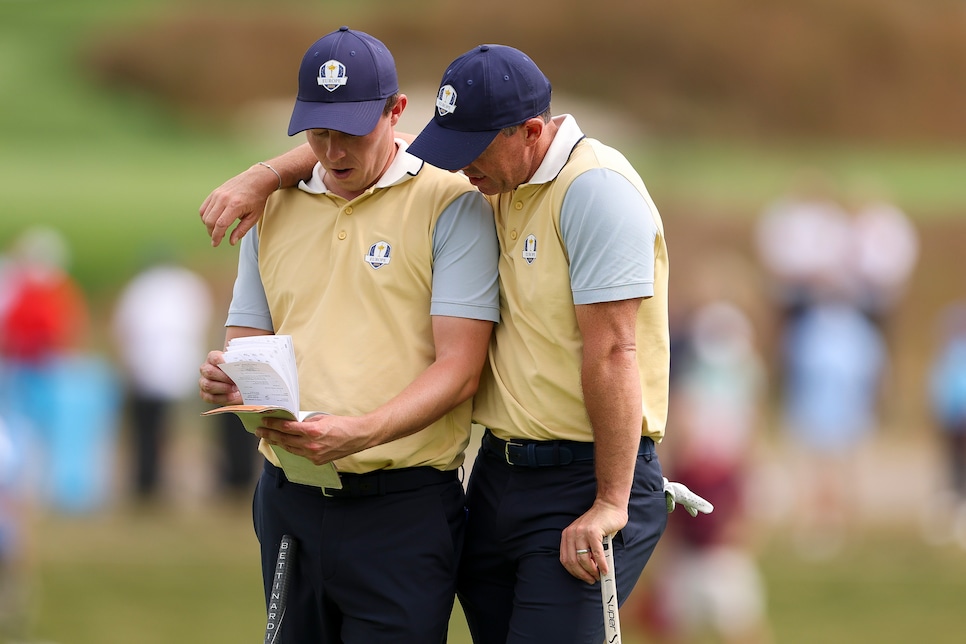FARMINGDALE, N.Y. — The Ryder Cup has a long and strange and wonderful history, but today we’re not focused on that. Today we’re focused on things that could happen, under the rules, that are unlikely but not impossible, as dictated by the captains’ agreement. A deep study of that document, signed in August by Keegan Bradley and Luke Donald, reveals these potential chaos-unleashing oddities and loopholes, and we’re going to list them now in the hope that at least one of them somehow comes true. Here are 12 largely unknown aspects of the captains’ agreement, and how they could potentially influence the action on the course.
1. A player can play a fourball match by himself
If a player gets sick or injured after the start of a singles or foursomes (alternate shot) match, that match is forfeited. But in fourball, a 2-on-2 format with each player scoring on his own ball, the teammate of the player who drops out could continue on his own. Imagine Scottie Scheffler heroically battling Jon Rahm and Rory McIlroy all by his lonesome—it’s completely possible. Even weirder, the teammate who dropped out could return, should his sickness or injury resolve.
2. Jim Furyk could get in trouble for taking a putt on Thursday
Check out this section at the start of the agreement:
“Assistant Captains may not practice putt or play any practice strokes on the golf course practice and competition rounds.”
Unfortunately, the agreement does not spell out what the penalty would be for a violation—I have to imagine they’d just tell him to stop—but I like to imagine a Furyk or Jose Maria Olazabal type getting his wrist slapped for taking a putt on a Thursday afternoon.
3. Players can practice on the course during the actual competition days
Nobody can practice before the morning matches or after holes are cut for the afternoon session, but if a player isn’t competing in the morning session on Friday and wants to get out on the course, he can go right ahead. The only rule is that you can’t start until 40 minutes after the last match goes off, and there must be a two-hole gap between the practicing player and the last match on the course. You rarely see this, probably because it would be odd to go out among the roars of actual competition with full grandstands, but it’s allowed.
4. In foursomes and singles, a team can lose the first hole if they’re between 1 and 5 minutes late
If any player in these two formats is more than five minutes late, that’s an outright disqualification and a loss of a point, as McIlroy nearly found at Medinah in his Sunday singles match against Bradley. But if you’re just slightly late—five minutes or less—you only lose the first hole. Incidentally, the official time is judged by the Rolex clock by the first tee.
5. Only the captains can give advice, and only in person
The quickest way to lose a hole in any match is for an assistant captain or anyone outside of the players and caddies within a match to give advice. The captain alone is allowed to give advice—the agreement literally calls him the “advice giver”—and it has to be in person. Any message conveyed over the radios or text message or any other digital means, and, buddy, that’s a lost hole.
An interesting side note here is that a captain can designate a new captain for one session if the captain himself will play in the session. That was added this year, back when it looked like Bradley would be a playing captain.
6. A five-hour round is considered fast in the fourball format
The pace-of-play section of the agreement defines a “scheduled time” for each format. For foursomes and singles, it’s about what you’d expect: 4 hours, 15 minutes for the former, 4:07 for the latter. But for fourball, with four players each on their own ball, it’s 5:07. Not a huge surprise, but interesting to get the exact figures. And pound for pound, the hole expected to take the longest is No. 15, the brutal, uphill par-4 which has the same “pace of play timing schedule” as the two par 5s.
7. Incomplete matches can go down as ties, even if one player is way ahead
Picture this: Rain has delayed the conclusion of the Ryder Cup until Monday, but they’re struggling to finish the singles session before sunset. Let’s say three matches are left on the course and the Americans are leading all three by huge margins, with the overall score of the match at 13-12 in favor of the Europeans. If the deciding hole on those three matches isn’t started six minutes prior to sunset—which the captains’ agreement defines as 6:34 p.m., six minutes before sunset—the matches would go down as a tie, and the final score would be a European victory, 14½-13½, despite the fact that the Americans were on the precipice of winning.
It could happen! But it would take a wild set of circumstances and two days worth of delays, because any matches delayed prior to Monday night are just resumed the next day.
Another note here: If a hole begins before 6:20 p.m., it must be finished, but holes started between 6:21 p.m. and 6:33 p.m. have to be completed unless both teams agree otherwise.
8. There’s a whole thing about handwritten notes in the yardage books

Matt Fitzpatrick and Rory McIlroy look at a yardage book during a practice round.
Andrew Redington
You can have them, but they have to come from personal knowledge, but also, you can tell other people about them, but only verbally … and I’m getting so confused that it may be better to just paste the language:
“NOTE: Handwritten notes that are added to the players Official Committee Approved Yardage book must come from first-hand experience by the player or his caddie observing a ball roll across a green and not from any electronic gadget or greens book, but these notes can be shared verbally with all team members and caddies.”
Again, it’s not 100 percent clear what the penalty would be for, say, one caddie texting another that the fifth green breaks toward the left, but it would be a heck of a way to lose a hole or a match.
9. The home team can influence the course, to a point, but not the tees and pins
This is a common misconception that the captains’ agreement clears up: When it comes to “direct set-up,” which refers to things like “fairway widths, rough heights, green speed and firmness,” the home team has discretion, but only up until Sept 21, which was last Sunday. After that, all decisions about course prep are decided by a “Match Committee” that consists of a representative from each team. And when it comes to tees and pins, those are chosen by the Match Committee in collaboration with each other. Both teams are told the five tees and pins for each session on each hole on the Monday before the Cup, (on Tuesday, I saw four hole markers laid out on the greens, along with the cut hole, to distinguish where those would be). But they aren’t told which location will apply to which session; those only come out before each session.
How do they prevent the Match Committee representative from telling the captain on the side? Honor code, baby.
10. A player could filibuster on the last hole of a match and single–handedly stall out the Ryder Cup
The pace-of-play language in the captains’ agreement is about what you’d expect, with warnings and eventually lost strokes and lost holes for bad times, but then there’s this language at the end:
“Players will not be timed on a hole where it is possible for a match to end.”
Scene: Patrick Cantlay is about to lose the match and the Ryder Cup on Sunday on the 18th hole but decides to study his putt for approximately 90 minutes, until darkness hits and they have to delay. Then he does the same all day on Monday, and at sundown the match goes down as a half. Technically, there is nothing to prevent this, and it would be the funniest moment in Ryder Cup history. But even on a less absurd note, remembering rule No. 7 above about tied matches, there’s ample opportunity for delay to prevent the finishing of a match, provided the Cup had already been delayed until Monday.
11. You have to finish singles matches even when the Ryder Cup outcome is determined
In the past, there were times when two players could agree to halve a match when the larger outcome was decided, but you can see why they’d want to abolish that now when TV isn’t eager to have hours of dead air in a blowout. Here, the agreement takes pains to say that a “handshake between players” only concedes each player’s subsequent stroke. I’m not sure why that’s in there, unless it’s to prevent a situation where players concede the match to each other, but officials don’t want them to do so, and thus it only counts for the next shot. I don’t see any language preventing players from shaking hands over and over to split the result of the rest of the match, although I do get the sense that would be frowned upon
12. There’s even a rule about the number of carts you’re allowed to have

U.S. captain Keegan Bradley rides in a golf cart at Bethpage.
Jamie Squire
Yes, seriously. You can have eight “Team Golf Cars,” but only six of them—carrying the captain and his maximum five assistants—are allowed inside the ropes. The other two have to stay outside, or else. And I realize as I type this that I’ve just given more fuel to the kind of people who call in from their couches when they spot a rules violation. All eyes on those extra carts, folks!
MORE GOLF DIGEST @ THE RYDER CUP COVERAGE
- Ryder Cup 101: Everything you need to know about this year’s match
- Power Rankings: Breaking down all 24 players competing at Bethpage Black
- How to watch the Ryder Cup: TV listings, Viewer’s Guide, Tee Times & more
- 10 questions a time traveler would ask attending the 2025 Ryder Cup
- Every hole at Bethpage Black
- Bethpage Black par-5 masterpiece, explained
- 15 moments that made the Ryder Cup golf’s most compelling duel
- GamePlan: 3 sneaky match-play tactics pros use at the Ryder Cup
- What’s the deal with players being paid to play the Ryder Cup? A Q&A
- 7 mistakes from 2023 the Americans need to avoid repeating
- Will Bethpage be a breaking point for fan behavior?
- Which U.S. Ryder Cup uniforms have aged the best (and worst)
This article was originally published on golfdigest.com




